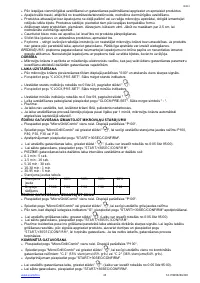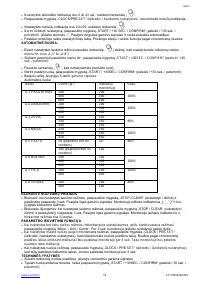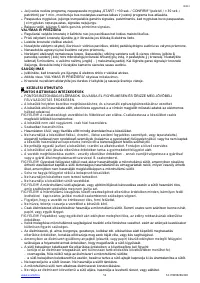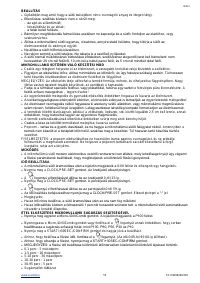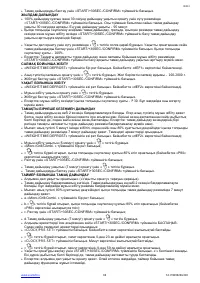Микроволновые печи Scarlett SC-MW9020G01D - инструкция пользователя по применению, эксплуатации и установке на русском языке. Мы надеемся, она поможет вам решить возникшие у вас вопросы при эксплуатации техники.
Если остались вопросы, задайте их в комментариях после инструкции.
"Загружаем инструкцию", означает, что нужно подождать пока файл загрузится и можно будет его читать онлайн. Некоторые инструкции очень большие и время их появления зависит от вашей скорости интернета.

IM012
5
APPLICABLE
•
Heat-proof glassware –
It is most suitable for microwave cooking.
•
Heat-resistant plastic container –
Do not use tightly closed containers. Cannot be used for packing or
containing foods with high fat or sugar contents.
•
Earthenware or chinaware –
Conventional utensils of these materials are allowed unless firmed with gold,
silver or any decorative metallic elements.
•
Special packing
(paper, plastic, etc.) for microwave ovens. Follow manufacture’s guides exactly when use.
INAPPLICABLE
•
Film for freshment preservation and heat-resistant combustible plastic wares
– Never apply for packing
meat or frying foods.
•
Metal wares (e.g. aluminum, stainless steel, etc.) and aluminum foil*
– W on’t let microwaves go through
and will spark or ignite touching the cavity wall during cooking.
* Applicable for wrapping several parts of product to prevent overheating and resulting burnt. Avoid contact with
interior walls, minimum distance must be more than 2 cm.
•
Plastics
– Unfit for microwave cooking.
•
Non-heat-proof glassware
– May deform or flaw in a highly hot circumstance. Curved or strengthened
glassware is not applicable.
•
Lacquer ware
– May flaw or peel off.
•
Paper, bamboo or wooden ware
– May be burnt while cooking.
•
Melamine dishes
– contain a material, which absorbs microwave energy. This may cause cracking of the
dishes or char and will slow down the cooking speed.
•
In those cases when plastic or paper containers are used to heat the food in the oven, watch the oven and
make sure the containers do not catch fire.
HOW TO IDENTIFY COOKWARE APPROPRIATENESS FOR MICROWAVE COOKING?
•
Put the intended cookware together with a glass of water (250 ml) inside the oven cavity, and then switch on
the oven at the maximum power for one minute.
•
Suitable for microwave cookware will be as cool as ever, while the water will absorb the energy and become
warmer.
USEFUL TIPS
•
For uniform heating turn over products during cooking.
•
Do not cook in a container with a restricted opening, such as a soft drink bottle or salad oil bottle, as they may
explode if heated in a microwave oven.
•
Do not use conventional meat or candy thermometers. These are thermometers available specifically for
microwave cooking. These may be used.
BEFORE YOU CALL FOR SERVICE
•
Check to ensure that:
–
Power supply is valid;
–
Timer settings are proper;
–
Door is securely closed engaging the door safety lock system.
RADIO INTERFERENCE
•
Operation of the microwave oven can cause interference to your radio, TV or similar equipment.
•
When there is interference, it may be reduced or eliminated by taking the following measures:
–
Clean doors and sealers;
–
Move the microwave oven away from the receiver;
–
Reorient the receiving antenna of radio or television.
–
Plug the microwave oven into a different outlet so that microwave oven and receiver are on different branch
circuits.
INSTALLATION
•
Make sure that all the packing materials are removed from the unit.
•
Check the oven for any damage in transit:
–
Misaligned or bent doors and sealers;
–
Housing and door window;
–
Inside surfaces.
•
If any damage occurs while using, switch off and unplug the oven and contact qualified service personnel.
•
Place the microwave oven on a flat, stable surface, able to hold its weight with a food to be cooked in the
oven.
•
Do not place the oven where heat, moisture or high humidity are generated, or near flammable materials.
•
Do not place anything on the oven. Do not block any openings on the appliance.
•
For correct operation, the oven must have sufficient airflow. Allow 20 cm free space above the oven, 10 cm
back and 5 cm from both sides.
MICROWAVE COOKING METHODS
•
Do not stack food. Arrange it in a single layer only. Place thicker pieces closer to dish edges.
•
Watch cooking time. Cook for the shortest amount of time indicated and add more if needed. Food severely
overcooked food may smoke or ignite.
NOTE:
Cooking time may also vary depending on products shape, cut and arrangement.
•
Cover products with special microwave lids or plastic wrap with one corner folded back to let out excess
steam. Lids and glass casseroles are very hot – handle it carefully!










































